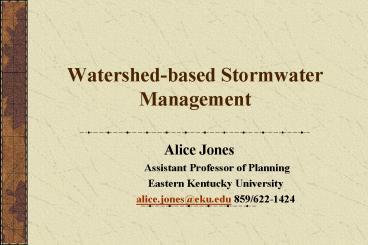Watershedbased Stormwater Management - PowerPoint PPT Presentation
1 / 18
Title:
Watershedbased Stormwater Management
Description:
Eastern Kentucky University. alice.jones_at_eku.edu ... concerned with moving water away from human activities quickly ... Direct Costs: property lost to erosion ... – PowerPoint PPT presentation
Number of Views:29
Avg rating:3.0/5.0
Title: Watershedbased Stormwater Management
1
Watershed-based Stormwater Management
- Alice Jones
- Assistant Professor of Planning
- Eastern Kentucky University
- alice.jones_at_eku.edu 859/622-1424
2
Watershed-based Stormwater Managemen
- Traditional approach
- concerned with moving water away from human
activities quickly and effectively - Separates management across water users
- Watershed or comprehensive approach
- concerned with maintaining quality waterways
- Recognizes multiple water users and potential
conflicts
3
The Three Cs
- Comprehensive
- considers all water and land uses throughout
watershed - Cumulative
- recognizes that water land uses in one area can
affect other users - Cooperative
- requires communication collaboration between
- political units
- local, state federal agencies
4
Managing Water Quality
- Point Sources
- Sewage pipes, industrial waste, illegal dumps
- Nonpoint Sources (about 2/3 states water
pollution) - Stormwater runoff
- Garden and ag chemicals, animal wastes, oils and
salts from pavement, sediment from bare ground
(development, mining, plowing, logging, etc.)
5
Stormwater Quality Concerns
- Nutrient Chemical Pollutants
- sources
- paved areas (oils, road salts)
- fertilizers and herbicides from farms and
suburban lawns - ag, industrial household cleaners other
chemicals - Sediment Pollutants
- sources
- bare farm fields
- construction sites
- streambank erosion
6
Stormwater Quantity Concerns
- Too Little
- Adequate flow for downstream users
- Municipal, agricultural users
- Stable aquatic life
- Too Much
- Potential flooding Erosion
- Property damage, hydrologic changes, ecological
changes
7
Effects of Urbanization on Stormwater Flow
- Suburban growth increases impervious surface
- higher storm peaks
- flashier storm profiles
8
Cumulative Downstream Impacts
- Downstream impacts are exponential
- Land use decisions in upstream location alters
land use downstream - Can create conflicts between communities
Time 1
Time 2
9
Land Use Stormwater Management
- Management Objectives
- reduce total runoff
- slow down runoff
- filter or settle out pollutants
- Management Techniques
- single-site and large-scale approaches
- temporary and long-term retention and detention
- naturalistic and engineered features
10
Addressing Stormwater Problems
- Detention/Retention Systems
- Shaving and Pushing the Peak of the Storm
Surge - Detention holds water temporarily
- Retention holds water more permanently
- Infiltration Systems
- Slow runoff
- Help water filter into ground
- Trap sediments
- filter pollutants
- Stabilize slopes
11
Questions of Regional Cooperation
- Who should design, build, inspect, and maintain
necessary structural improvements? - How are improvements to be funded?
- Who establishes management priorities
- Who decides how success should be evaluated?
12
Voluntary Stormwater Management Approaches
- Examples
- land banking or land trusts
- voluntary Best Management Practices (BMPs)
- Advantages
- little political controversy
- Disadvantages
- not comprehensive--piecemeal efforts may not
have desired results - no landowner incentive to comply
- available program funds not reliable
13
Public-Oriented Options
- examples
- land use regulations
- large-scale retention, detention structures
- growth management controls
- advantages
- variety and flexibility
- compliance is enforceable
- effect is regional
- disadvantages
- requires political units agencies to cooperate
- private land use restrictions politically
contentious
14
Areas for Cooperation in Watershed Management
- Regular Communications about Land Use plans and
decisions - Joint Efforts to Build and Maintain Large-Scale
BMPs where needed - Cooperative water quality monitoring and other
watershed studies
15
Consistent Regulations
- required sediment control during construction
- developer responsibility for healthy vegetation
- construction restrictions in stream buffer
corridors - performance criteria (e.g., no net runoff gain)
- plan review fee for maintenance and inspection
fund - Helps avoid weakest link developer- county
problems
16
Watershed Management Potential
- Guide Development to
- Preserve quality of stream habitat
- Protect rural character of region
- Build and maintain strong, diverse, and healthy
communities - Take Active Steps to
- Protect against flood damage
- Reduce stream bank erosion
- Avoid stream sediment pollution during
construction - Preserve agricultural land
17
Costs of Management Failure
- Direct Costs
- property lost to erosion and flooding
- property owner repairs for water-related damage
- increased county municipal drainage
construction and maintenance - Indirect Costs
- loss of plant and animal species
- lost recreational aesthetic amenities
- reduced regional quality of life
18
Kentucky Watershed Management Framework
- Purposes
- Protect water quality
- Maintain economic growth
- Save taxpayer money
- Encourage local action
- Draft Plan
- http//www.uky.edu/WaterResources/Watershed/
- Select Kentucky River Basin Management Plan































